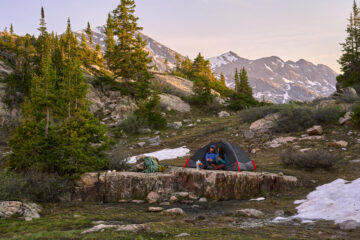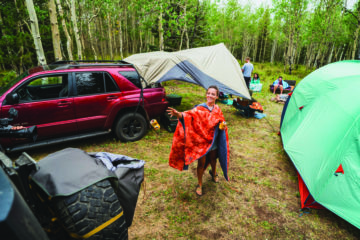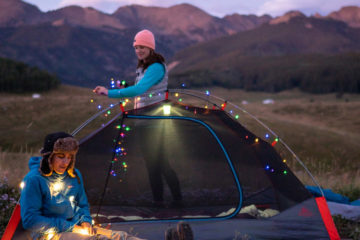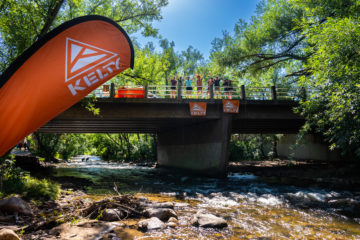
We’re coming up on the shortest day of the year, and it can be easy to forget that natural beauty doesn’t end at sundown. The International Dark Sky Places (ISDP) designation is a 20-year-old global program that protects low-light-pollution places around the world so that regular folks like us can get a really good look at the stars with or without a telescope.
This year, the night sky is taking it to the next level. Meet the “Christmas Star”. What is the “Christmas Star”? Saturn and Jupiter will align, looking like a “double planet” for the first time since the Middle Ages— we’re talking year 1226. This jaw-dropper will be visible anywhere on Earth where skies are clear. If you’re in the northern hemisphere, look low in the southwestern/western sky about 45 minutes to an hour after sunset. They’ll be closest on December 21st, but you can see it each evening that week.
Whether you’re headed out to see this rare celestial event, or mapping out your next adventure, here are four amazing places for all you night rangers to get lit. Plus, some gear to go with.
Great Sand Dunes National Park / Southern Colorado
The Dunes are already otherworldly during the daytime; at night, it’s easy to imagine you’re on another planet. It’s also one of the only wild places in the world where rangers encourage self-guided exploration…in total darkness! To take a gorgeously surreal night-hike without the aid of a flashlight, plan your visit during a full moon; you may be treated to glimpses of the local wildlife, including owl, kangaroo rat, coyote and even bobcat. If you’re more interested in sky than sand, go during the new moon instead; you can pick up a free star chart and moon calendar at the Visitor Center.
GEAR TIP: Nights get cold on the dunes, so you’d better bring along a Bestie Blanket to snuggle up with around the campfire. Bonus: it doubles as a sled on those crazy dunes!
Anza Borrego Desert State Park / Southern California
About two hours east of San Diego, Anza Borrego is the largest state park in the lower 48. While you’ll obviously miss wildflower season if you go this time of year, you’ll still find a delightfully diverse selection of terrain to explore within the park’s 1,000 square miles—from sunny, cactus-covered hillsides to shady slot canyons and brooding badlands.
Thanks to the park’s massive footprint, local light pollution is nearly non-existent, allowing the stars to take center stage. On exceptionally clear nights, it’s even possible to see the Milky Way. Fish Creek (4WD) and Blair Valley (2WD) Primitive Campgrounds are both excellent spots for stargazing, so you can enjoy the show from the comfort of your sleeping bag.
GEAR TIP: Our Mistral Sleeping Bag will kill the cold without killing your budget. Because what good is overpriced gear when you don’t have the money left over for high quality snacks and gas to get there?
Westcliffe + Silver Cliff / Custer County, Colorado
Like your constellations with a side of civilization? Located about an hour west of Pueblo, the two towns of West Cliff and Silver Cliff recently became the first communities in Colorado to be recognized by the International Dark-Sky Association (IDA). Not surprisingly, the area is home to many passionate stargazers; soon after receiving certification, the community constructed the Smokey Jack Observatory, where visitors can absorb the full impact of an unobstructed Milky Way through a computer-guided Schmidt-Cassegrain telescope.
GEAR TIP: While there are stunning trails all around, many with spectacular views of the Sangre de Cristo mountain range, you’re also just a short drive away the ghost towns of Querida and Rosita. Grab a light daypack like our Agate 24 and go exploring!
Bryce Canyon / Southern Utah
Here’s the thing about Bryce Canyon: there just isn’t a bad time to go. Sure, it’s a little colder in the winter, and not all of the trails will be open—but the tradeoff is getting those spectacular hoodoos (the park’s signature bright-orange rock spires) all to yourself. Not surprisingly, snow transforms landscape into a frozen fantasyland. And we’re not even here to talk about the daytime, folks! There is top-notch stargazing at Natural Bridge Overlook as well as Sunset and Sunrise Points; these two provide gorge-eous views of Bryce Amphitheater.
GEAR TIP: No need to pack light for this one! Campgrounds are closed in the winter, so throw everything in a Redwing 50 and load up the car for either a nearby hotel or nearby dispersed camping.












